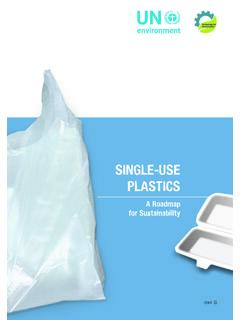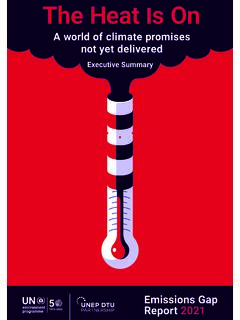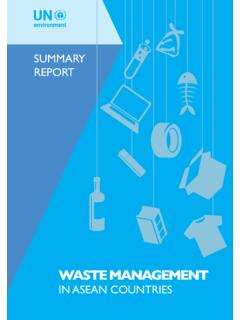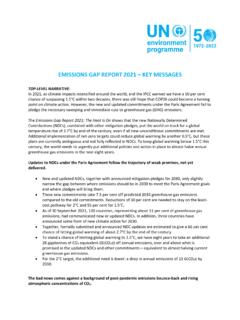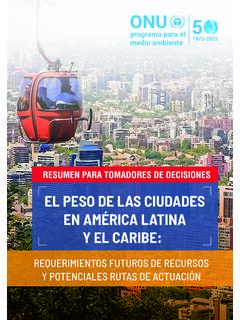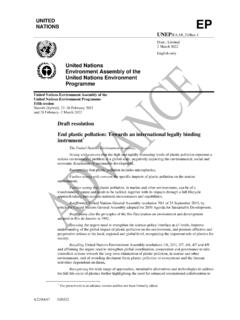Transcription of GLOBAL METHANE ASSESSMENT
1 GLOBAL METHANE ASSESSMENTS ummary for Decision MakersCopyright united nations environment programme , 2021 This publication may be reproduced in whole or in part and in any form for educational or non-profit purposes without special permission from the copyright holder, provided acknowledgement of the source is made. The united nations environment programme would appreciate receiving a copy of any publication that uses this publication as a use of this publication may be made for resale or for any other commercial purpose whatsoever without prior permission in writing from the united nations environment designations employed and the presentation of the material in this publication do not imply the expression of any opinion whatsoever on the part of the Secretariat of the united nations
2 Concerning the legal status of any country, territory, city or area or of its authorities, or concerning delimitation of its frontiers or boundaries. Moreover, the views expressed do not necessarily represent the decision or the stated policy of the united nations environment programme , nor does citing of trade names or commercial processes constitute citation: united nations environment programme and Climate and Clean Air Coalition (2021). GLOBAL METHANE ASSESSMENT : Benefits and Costs of Mitigating METHANE Emissions.
3 Nairobi: united nations environment : 978-92-807-3854-4 Job No: DTI/2352/PA3 GLOBAL METHANE ASSESSMENT / ACKNOWLEDGEMENTSACKNOWLEDGEMENTSASSESSME NT CHAIRDrew ShindellAUTHORSA. R. Ravishankara, Johan Kuylenstierna, Eleni Michalopoulou, Lena H glund-Isaksson, Yuqiang Zhang, Karl Seltzer, Muye Ru, Rithik Castelino, Greg Faluvegi, Vaishali Naik, Larry Horowitz, Jian He, Jean-Francois Lamarque, Kengo Sudo, William J. Collins, Chris Malley, Mathijs Harmsen, Krista Stark, Jared Junkin, Gray Li, Alex Glick, Nathan Borgford-ParnellAFFILIATIONSDuke University: Drew Shindell, Yuqiang Zhang, Karl Seltzer, Muye Ru, Rithik Castelino, Krista Stark, Jared Junkin, Gray Li, Alex GlickNASA Goddard Institute for Space Studies/Columbia University: Greg FaluvegiGeophysical Fluid Dynamics Laboratory (GFDL): Vaishali Naik, Larry Horowitz, Jian HeNational Center for Atmospheric Research (NCAR): Jean-Francois LamarqueNagoya University.
4 Kengo SudoUniversity of Reading: William J. CollinsStockholm environment Institute (SEI): Johan Kuylenstierna, Chris Malley, Eleni MichalopoulouColorado State University, Fort Collins: A. R. RavishankaraInternational Institute for Applied Systems Analysis (IIASA): Lena H glund-IsakssonNetherlands Environmental ASSESSMENT Agency (PBL): Mathijs HarmsenClimate and Clean Air Coalition (CCAC): Nathan Borgford-ParnellTECHNICAL REVIEWERSV alentin Foltescu (Climate and Clean Air Coalition); Yangyang Xu (Texas A&M University, USA).
5 Durwood Zaelke (Institute for Governance & Sustainable Development), Kristin Campbell (Institute for Governance & Sustainable Development); Gabrielle Dreyfus (Institute for Governance & Sustainable Development); Ben Poulter (National Aeronautics and Space Administration, US); Kathleen Mar (Institute for Advanced Sustainability Studies); Ilse Aben (Netherlands Institute for Space Research); Christopher Konek ( united nations environment programme ); Vigdis Vestreng (Norwegian environment Agency); Arif Goheer ( GLOBAL Change Impact Studies Centre, Pakistan), Shaun Ragnauth ( united States Environmental Protection Agency).
6 Technical Advisor for the GLOBAL Change ASSESSMENT Model (GCAM): Daniel Loughlin ( united States Environmental Protection Agency) COPY EDITOR: Bart UllsteinMANAGING EDITOR: Tiy ChungGRAPHIC DESIGN AND LAY-OUT: Katharine MugridgeEXECUTIVE SUMMARY5 GLOBAL METHANE ASSESSMENT / EXECUTIVE SUMMARYR educing human-caused METHANE emissions is one of the most cost-effective strategies to rapidly reduce the rate of warming and contribute significantly to GLOBAL efforts to limit temperature rise to C. Available targeted METHANE measures, together with additional measures that contribute to priority development goals, can simultaneously reduce human-caused METHANE emissions by as much as 45 per cent, or 180 million tonnes a year (Mt/yr) by 2030.
7 This will avoid nearly C of GLOBAL warming by the 2040s and complement all long-term climate change mitigation efforts. It would also, each year, prevent 255 000 premature deaths, 775 000 asthma-related hospital visits, 73 billion hours of lost labour from extreme heat, and 26 million tonnes of crop losses globally (Figure ES1).Figure ES1: Current and projected anthropogenic METHANE emissions and the identified sectoral mitigation potential in 2030 along with several benefits associated with sectoral-level METHANE emissions mitigation.
8 Avoided warming occurs in the 2040s, other impacts are annual values beginning in 2030 that would continue METHANE ASSESSMENT / EXECUTIVE SUMMARYThe findings in this ASSESSMENT are the result of modelling that uses five state-of-the art GLOBAL composition-climate models to evaluate changes in the Earth s climate system and surface ozone concentrations from reductions in METHANE emissions. Results allow for rapid evaluation of impacts from METHANE emissions and the benefits from mitigation strategies to the climate and ground-level ozone formation and, air quality, public health, agricultural and other development benefits.
9 The ASSESSMENT results are also available in a web-based decision support tool1 that allows users to input different METHANE emissions reduction goals to calculate the multiple benefits at a national OPPORTUNITY More than half of GLOBAL METHANE emissions stem from human activities in three sectors: fossil fuels (35 per cent of human-caused emissions), waste (20 per cent) and agriculture (40 per cent). In the fossil fuel sector, oil and gas extraction, processing and distribution account for 23 per cent, and coal mining accounts for 12 per cent of emissions.
10 In the waste sector, landfills and wastewater make up about 20 per cent of GLOBAL anthropogenic emissions. In the agricultural sector, livestock emissions from manure and enteric fermentation represent roughly 32 per cent, and rice cultivation 8 per cent of GLOBAL anthropogenic emissions. (Sections 1, and ) Currently available measures could reduce emissions from these major sectors by approximately 180 Mt/yr, or as much as 45 per cent, by 2030. This is a cost-effective step required to achieve the united nations Framework Convention on Climate Change (UNFCCC) C target.
